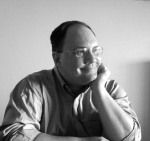A few weeks ago, I came across this video of composer Sofia Gubaidulina discussing her violin concerto, “In Tempus Praesens”. What intrigued me was a statement she made about musical form and the process of composing at about two-minutes fifty-seconds into the video:
“Just working intuitively is not good for the arts. Fantasies of some kind or other come along — that’s too materialistic. When I listen to pieces that are written solely with intuition, I’m not satisfied. But I’m very satisfied when I listen to pieces by Johann Sebastian Bach that contain both: those mathematical principles and the fiery current of intuition.”
Her statement comes out of a larger discussion of the form of “In Tempus Praesens”, and her use of the Fibonacci sequence in creating the structure of the piece. Although the video is not completely clear on how this works, it does suggest that the mathematical sequence relates to the durations of musical elements in the piece — perhaps notes, harmonies, or sections… it isn’t clear. What we can infer is that the Fibonacci sequence serves as the form of the piece, or the structure in which the musical events take place. And it’s this type of structure, which the composer has chosen at the beginning of the process of writing the piece, and which is a central element affecting all the other aspects of the piece (such as the shape of melodies and harmonies, and how sections relate to each other), that Gubaidulina advocates over music in which the form is not pre-chosen but is shaped during the process of assembling other elements of the piece. It’s a question of how significant musical form is in a piece.
But what caught my attention is Gubaidulina’s broader assertion that composing by intuition alone is not good. Sure, a lot of my own music exhibits the unfolding of processes or complex and changing interrelations that I consider to be structural features, similar to the way form works in “In Tempus Praesens”. But I also write music in which I don’t have a plan at the beginning of the process for how things will develop and progress. I work intuitively, developing and varying my melodic, harmonic, and rhythmic material, and letting what I create suggest how I should proceed. These are different ways of working, and I’m not convinced that the former is superior to the latter.
I’ve also heard the statement “composing by intuition” used in a different way: in terms of harmonic language and pitch selection. I was recently asked, concerning one of my compositions, if I had used some kind of system to choose my pitches (12-tone or pitch-class set) or if I had relied on intuition. During my early training, I worked to develop a pretty good ear for choosing pitches, and for me it’s one of the most pleasurable (and frustrating) challenges of writing music. I don’t have a problem with choosing notes through a system like serialism or set theory, but I don’t consider it a superior method to working intuitively.
What was Gubaidulina advocating with her warning about intuition? She described music composed intuitively as “fantasies”, a term that historically denoted compositions exhibiting an improvisatory nature and not adhering to a preset musical form. A fantasy can tend to wander around freely, and listeners may never be sure where the music is going. I think that’s what Gubaidulina is getting at: music that employs what she calls “mathematical principals”–essentially meaning a carefully designed structure–usually exhibits a more economical use of material, a clearer presentation of musical ideas, and a sense of control and certainty as the piece progresses.
I’ve written a lot of “inventions”, where an entire piece is derived from a few short motives, so I appreciate the ingenuity and creativity that musical economy engenders. I consider musical form to be a critical part of my own works, and I’m always thinking about the unfolding of processes in my music and the changing relationships between musical events. I appreciate that too much reliance on intuition may be bad for this kind of composition. But I also think that Gubaidulina’s statement is dependant on her aesthetic stance. She seems to like tight, clear, directed musical form. But what’s wrong with structure that’s a bit looser and ambiguous? What’s wrong with wandering a bit? I’ve spent most of my life making pieces that are tight and clear in their structure, but why couldn’t I choose to be a bit more free in how I assemble my material? Must art be economical and ordered? Or can it be messy?
Of course, order is important to clarity, and clarity is critical to communication. Music is especially difficult to interpret well, and compositions with unambiguous form help the listener in finding meaning. But there’s no reason working intuitively will produce a confusing result, or will prevent the listener from appreciating a piece. Also, it’s important to understand that there is difference between the musical work and processes and procedures that generated the piece. How a composition was created–using mathematical systems, or working intuitively–may or may not be evident in the finished work.
I think intuition plays an important role in the creative process. Using instinct to decide how a musical event develops and changes, and to answer the question “what happens next?”, is an important part of the procedure of creating a piece. But another important part of the process is designing a structure in which the musical events are presented in a clear, directed, meaningful way. It’s holding “intuition” in balance with “mathematical principals” that creates really satisfying compositions.
What do you think? I’d like to hear your response to these issues, or to find out what role intuition plays in your music.


